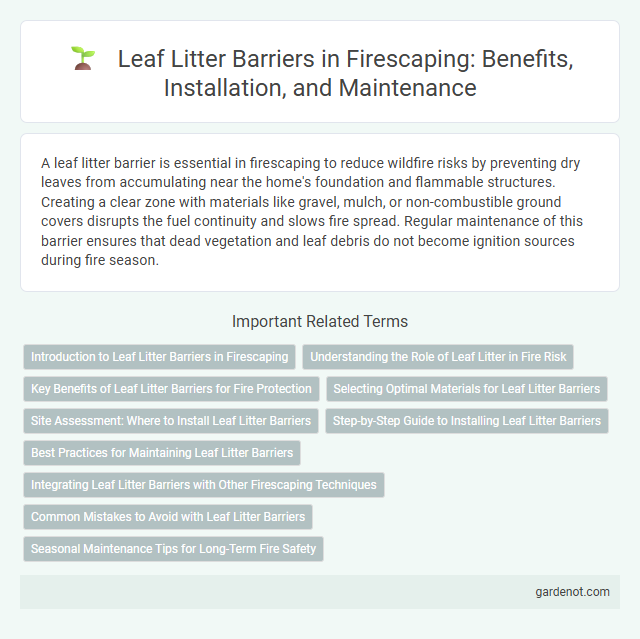A leaf litter barrier is essential in firescaping to reduce wildfire risks by preventing dry leaves from accumulating near the home's foundation and flammable structures. Creating a clear zone with materials like gravel, mulch, or non-combustible ground covers disrupts the fuel continuity and slows fire spread. Regular maintenance of this barrier ensures that dead vegetation and leaf debris do not become ignition sources during fire season.
Introduction to Leaf Litter Barriers in Firescaping
Leaf litter barriers serve as critical defenses in firescaping by reducing combustible organic debris near structures and landscapes. These barriers, often composed of non-flammable materials like gravel, stone, or fire-resistant mulch, interrupt the continuity of dry leaves and twigs that can fuel wildfires. Proper installation of leaf litter barriers minimizes fire spread risk by limiting available fuel and promoting safer ignition zones around properties.
Understanding the Role of Leaf Litter in Fire Risk
Leaf litter acts as a significant fuel source in fire-prone areas, increasing the intensity and spread of wildfires by providing easily ignitable material. Effective firescaping strategies involve creating leaf litter barriers that reduce combustible debris accumulation near structures, minimizing fire risk. Regular removal or management of leaf litter helps maintain defensible space and promotes landscape resilience against wildfire threats.
Key Benefits of Leaf Litter Barriers for Fire Protection
Leaf litter barriers reduce combustible materials near structures, significantly lowering wildfire ignition risk. They create a defensible space by preventing the accumulation of dry leaves and organic debris that act as fuel for fires. This strategic removal enhances property safety and supports effective fire prevention measures.
Selecting Optimal Materials for Leaf Litter Barriers
Choosing optimal materials for leaf litter barriers involves prioritizing fire-resistant, non-flammable options such as gravel, crushed stone, or concrete pavers that effectively prevent accumulation of combustible debris near structures. Durable, permeable materials enhance drainage while minimizing organic buildup, reducing fire risk and promoting landscape health. Incorporating metal or masonry edging also stabilizes the barrier, preventing encroachment of leaf litter into defensible space zones critical for wildfire protection.
Site Assessment: Where to Install Leaf Litter Barriers
Leaf litter barriers should be installed in areas prone to wildfire ignition, such as along property edges, near structures, and around vegetation clusters. Site assessment involves evaluating slope, prevailing wind direction, and fuel load to determine high-risk zones where barriers can interrupt the continuous fuel bed. Strategic placement reduces fire intensity by preventing leaf litter accumulation in defensible spaces and firebreaks.
Step-by-Step Guide to Installing Leaf Litter Barriers
Installing leaf litter barriers involves first clearing debris and dry leaves from the designated fire-prone area to create a clean surface. Next, lay down a fire-resistant barrier material such as gravel, stone mulch, or metal mesh, ensuring it extends several feet beyond the structure's perimeter for effective protection. Secure the barrier edges and maintain regular inspections to prevent accumulation of new leaf litter, thereby reducing wildfire risks around your property.
Best Practices for Maintaining Leaf Litter Barriers
Maintaining leaf litter barriers requires regular removal of dry leaves and debris to prevent fuel buildup that can ignite during wildfires. Using non-combustible materials like gravel or stone as the base enhances the effectiveness of the barrier by reducing flammable organic matter accumulation. Ensuring the barrier is at least three feet wide and free from overhanging vegetation optimizes its function as a firebreak in firescaping.
Integrating Leaf Litter Barriers with Other Firescaping Techniques
Integrating leaf litter barriers with mulching, fire-resistant plants, and strategic hardscaping enhances overall fire protection by creating multiple layers of defense against wildfire ignition. Combining these techniques reduces combustible materials near structures and interrupts fire spread pathways, significantly lowering wildfire risk. Proper maintenance of leaf litter barriers, including regular removal and placement around defensible space zones, maximizes their effectiveness within a comprehensive firescaping plan.
Common Mistakes to Avoid with Leaf Litter Barriers
Common mistakes to avoid with leaf litter barriers include using non-breathable materials that trap moisture, leading to mold and decay around plant roots. Installing barriers too close to tree trunks can create a fire hazard by concentrating dry debris and preventing proper airflow. Failing to regularly clean and maintain the barrier allows accumulation of leaf litter, undermining its effectiveness in reducing wildfire fuel loads.
Seasonal Maintenance Tips for Long-Term Fire Safety
Regular removal of leaf litter from gutters, patios, and around the home significantly reduces combustible materials that fuel wildfires. Utilizing mulches like gravel or stone instead of organic mulch helps prevent accumulation of flammable debris. Scheduling seasonal cleanups in late fall and early spring maintains a defensible space, enhancing long-term fire safety.
Leaf litter barrier Infographic

 gardenot.com
gardenot.com